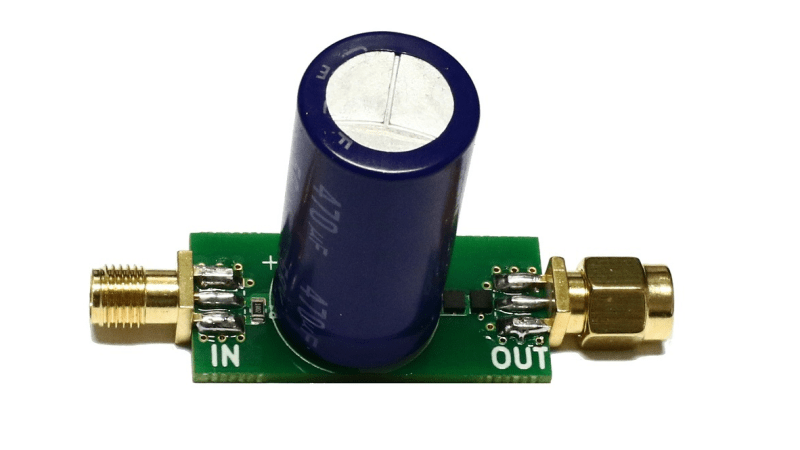We all know how to block the DC offset of an AC signal — that just requires putting a capacitor in series, right? But what if the AC signal doesn’t alternate very often? In that case, things get a little more complicated.
Or at least that’s what [Limpkin] discovered, which led him to design this low-frequency DC block. Having found that commercially available DC blocks typically have a cutoff frequency of 100 kHz, which is far too high to measure power rail ripple in his low-noise amplifier, he hit the books in search of an appropriate design. What he came up with is a non-polarized capacitor in series followed by a pair of PIN diodes shunted to ground. The diodes are in opposite polarities and serve to limit how much voltage passes out of the filter. The filter was designed for a cutoff frequency of 6.37 Hz, and [Limpkin]’s testing showed a 3-dB cutoff of 6.31 Hz — not bad. After some torture testing to make sure it wouldn’t blow up, he used it to measure the ripple on a bench power supply.
It’s a neat little circuit that ended up being a good learning experience, both for [Limpkin] and for us.
















It would be interesting to see what a very low esr capacitor would achieve.
One potential option would be to use a capacitance multiplier instead of a large cap.
https://en.wikipedia.org/wiki/Capacitance_multiplier?wprov=sfla1
No — that would add noise to the circuit.
A capacitance multiplier does not multiply capacitances! That won’t work here!
Multiple smaller caps in parallel also increases capacitance while decreasing ESR.
Big Limpkin fan here. Love his rigorous approach and instrumentation. Thanks for sharing, the bipolar cap is new to me, and I’m a grey beard :-)
Think of 2 unipolar caps in series opposing, and in fact you can build one that way. Remember that 2 equal caps in series will have half the total value. The voltage rating will not change however.
I measure my ripple by the ounce. If this doesn’t interface with my shot glass, I don’t see it helping at all!
Works great for low impedance amplifiers, for high impedance amplifiers the current noise of capacitor leakage creeps in. At which point you have to use exotic capacitors like William’s AN124 wet tantalums, or with a differential input you can use an integrator to servo the other input.
Power rail ripple in a low noise amplifier powered by (2) 9 volt batteries?
Measuring the ripple in a bench power supply, yes; that’s more how my brain works.
Once your measurements become this precise you’ll quickly find out that batteries are a hell of a noise source thanks to their microphonics and fluctuations in chemical reaction rate.
Thank you for your rebuttal to my comment, could you provide a quantitative value rather than “a hell of a noise”. Because to me a hell of a noise is what my wife sounds like when I am enjoying symphonic music through my White Oak Audio-modified Phase Linear 700B amplifier and my Carver “Amazing” loudspeakers.